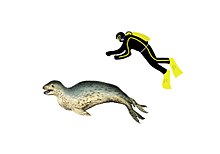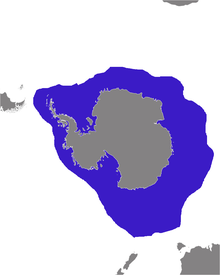
Back Seeluiperd Afrikaans نمر البحر Arabic نمر البحر ARZ Spedol (Hydrurga leptonyx) AVK Dəniz bəbiri Azerbaijani دنیز قاپلانی AZB Марскі леапард Byelorussian Марскі леапард BE-X-OLD Леопардов тюлен Bulgarian লেপার্ড সিল Bengali/Bangla
| Leopard seal[1] Temporal range: Early Pliocene – Recent
| |
|---|---|

| |
| At the Antarctic Sound, near Brown Bluff, Tabarin Peninsula | |

| |
| Size compared to a 1.82 m (6ft) human | |
| Scientific classification | |
| Domain: | Eukaryota |
| Kingdom: | Animalia |
| Phylum: | Chordata |
| Class: | Mammalia |
| Order: | Carnivora |
| Clade: | Pinnipedia |
| Family: | Phocidae |
| Subfamily: | Monachinae |
| Tribe: | Lobodontini |
| Genus: | Hydrurga Gistel, 1848 |
| Species: | H. leptonyx
|
| Binomial name | |
| Hydrurga leptonyx (Blainville, 1820)
| |

| |
| Hydrurga leptonyx range map | |
| Synonyms | |
| |
The leopard seal (Hydrurga leptonyx), also referred to as the sea leopard,[3] is the second largest species of seal in the Antarctic (after the southern elephant seal). Its only natural predator is the orca.[4] It feeds on a wide range of prey including cephalopods, other pinnipeds, krill, fish, and birds, particularly penguins. It is the only species in the genus Hydrurga. Its closest relatives are the Ross seal, the crabeater seal and the Weddell seal, which together are known as the tribe of Lobodontini seals.[5][6] The name hydrurga means "water worker" and leptonyx is the Greek for "thin-clawed".
- ^ Wilson, Don E.; Seeder, Dee Ann M., eds. (2005). "Species: Hydrurga leptonyx". Mammal species of the world : a taxonomic and geographic reference (3rd ed.). Baltimore: Johns Hopkins University Press. ISBN 978-0-8018-8221-0.
- ^ Hückstädt, L. (2015). "Hydrurga leptonyx". IUCN Red List of Threatened Species. 2015: e.T10340A45226422. doi:10.2305/IUCN.UK.2015-4.RLTS.T10340A45226422.en. Retrieved 20 February 2022.
- ^ "Leopard seal". Encyclopedia Britannica. 1998.
- ^ Cite error: The named reference
Auswas invoked but never defined (see the help page). - ^ Wilson, Don E.; Reeder, DeeAnn M., eds. (2005). "Family: Phocidae". Mammal species of the world : a taxonomic and geographic reference (3rd ed.). Baltimore: Johns Hopkins University Press. ISBN 978-0-8018-8221-0.
- ^ Berta, Annalisa (2009). "Pinnipedia: Overview". In Perrin, W. F.; Würsig, B.; Thewissen, J. G. M. (eds.). Encyclopedia of Marine Mammals (2nd ed.). Academic Press. pp. 878–85. ISBN 978-0-12-373553-9.
